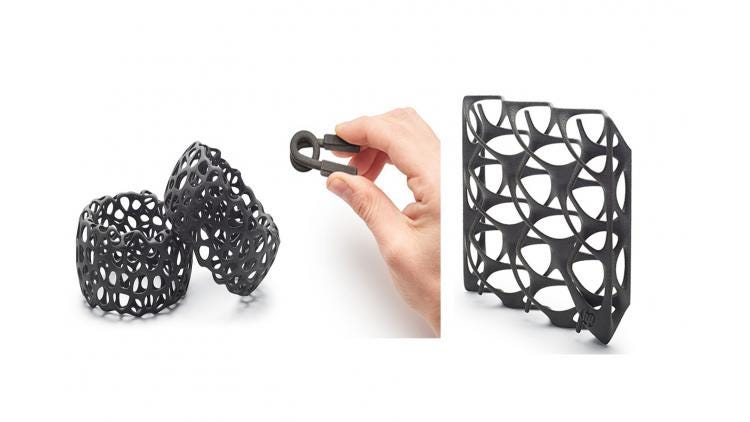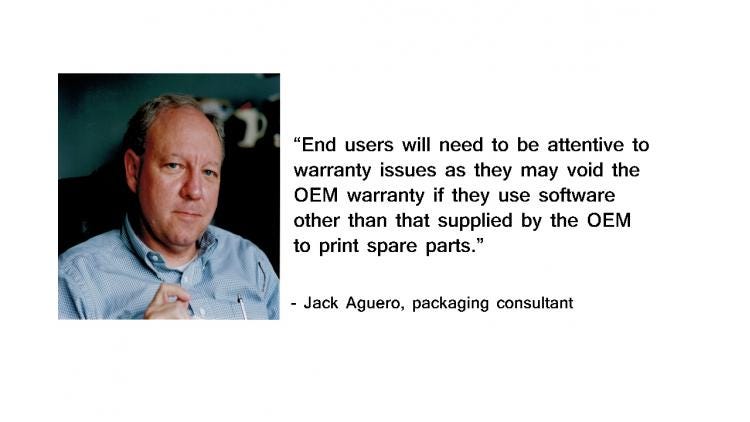September 14, 2016

Parts are parts…but what happens when those parts are 3D printed for use on packaging machinery? Suffice to say that vendors and brand owners will be affected in different ways. Here’s advice from an industry insider.
3D printing, additive manufacturing and direct digital manufacturing are some of the terms used today for the printing of parts. A review of the technology and its applications show investments are being made that will impact packaging machinery manufacturers.
A U.S. accelerator for 3D printing, America Makes, the National Additive Manufacturing Innovation Institute, was founded in Youngstown, OH, in 2012. In August 2015, a satellite center in El Paso, TX, was announced, representing an $87 million investment in a 13,000 sq. ft. facility using 50 additive machines. America Makes has over 160 member institutions from business, universities, nonprofits and government organizations. Its focus is on the design, materials, technology and workforce for 3D printing.
In April 2016 General Electric announced the opening of the Center for Additive Technology Advancement in Pittsburgh, PA. This center represents a $39 million investment over 3 years and will focus on developing and implementing industrial applications for 3D printing.
HP and UPS have also gotten into the 3D printing market. UPS is offering on-site 3D printing in selected UPS stores and is aiming at a target market of low volume replacement parts while HP is turning out 3D printers that will continue to evolve in power and speed as they come out with newer models.
The Department of Energy Oak Ridge National Laboratory and Cincinnati Inc. are partnered to develop 3D technology that will be 200 to 500 times faster and capable of printing polymer components 10 times larger than today’s printers.

Today's 3D printers permit complex shapes to be made, opening up new opportunities for printed parts for packaging machinery. Photo: HP
What it means for packaging
What does this mean for packaging machinery manufacturers? I saw one example of a robotic arm made with a 3D printer at interpack 2014, and heard about an example of a 3D printed application at Pack Expo 2015. I assume that 3D printing is being used by Original Equipment Manufacturers (OEMs) for the rapid prototyping of parts, for molds and other experimental applications. I suggest that our industry will be affected in ways that could be very disruptive to the current business model of supplying replacement for critical spare parts.
In the near future it may seem so very quaint to have manufactured a spare part in Middle America and then to have shipped it half way around the world to be installed in a machine at a customer’s manufacturing plant. The examples in the evolution of this technology outside the OEM business model may foretell a disruptive technology for the manufacturing, shipping and fulfillment markets.

A future scenario
There may be a scenario in the future where the packaging machine is sold with an additional package that contains all the necessary software information for the end user to print out critical spare parts using 3D printing on site at their manufacturing plant. This will cause OEMs to have to adjust their business model, as they may not realize the same revenue and profitability from the spare parts business that they enjoy today.
End users will need to be attentive to warranty issues as they may void the OEM warranty if they use software other than that supplied by the OEM to print spare parts.
I suggest that it will be a prudent step for all packaging machinery manufacturers to experiment with this technology with the goal of mastering it and applying it where it makes business sense today and, in addition, look towards the future to understand its probable effect on the replacement parts business model.
End users should continue to monitor developments in 3D printing technology and be alert for applications that will assist them in keeping their packaging lines up and running efficiently.
3D printing is a technology that has the impetus to reach “take off” on the packaging lines and the manufacturing plants of the future.
Jack Aguero is a veteran of the packaging machinery manufacturing industry. He currently serves on the board of the Septimatech Group Inc. and is an advisor to OMAC. He can be reached by email at [email protected]
Check out Packaging Digest's previous content related to 3D printing.
_________
Explore cutting-edge packaging, manufacturing and automation solutions from hundreds of exhibitors at MinnPack (Sept. 21-22; Minneapolis). Use discount code PDigest16 to get 20% off your conference registration.
___________________________________________________________________________________
About the Author(s)
You May Also Like


